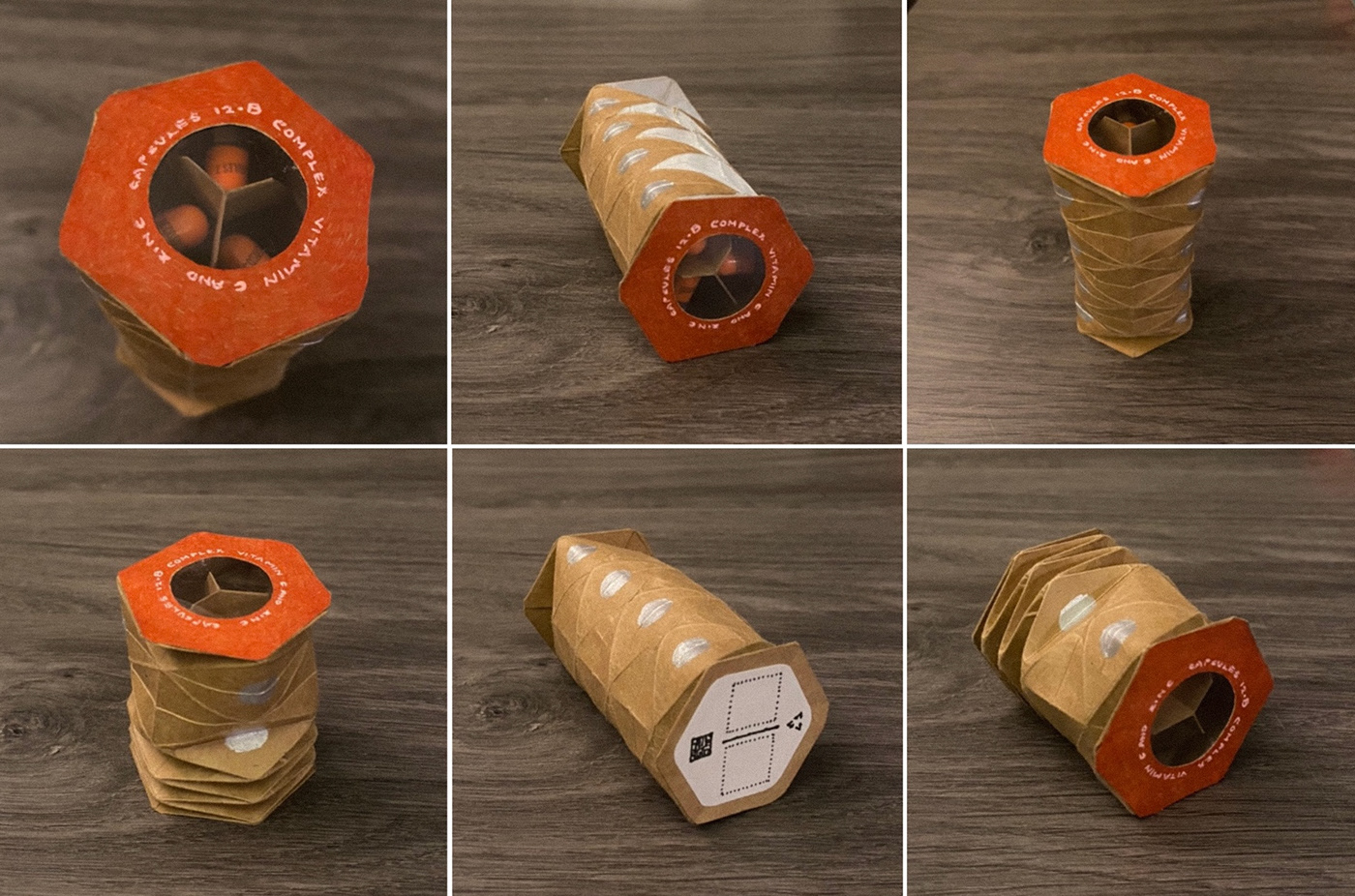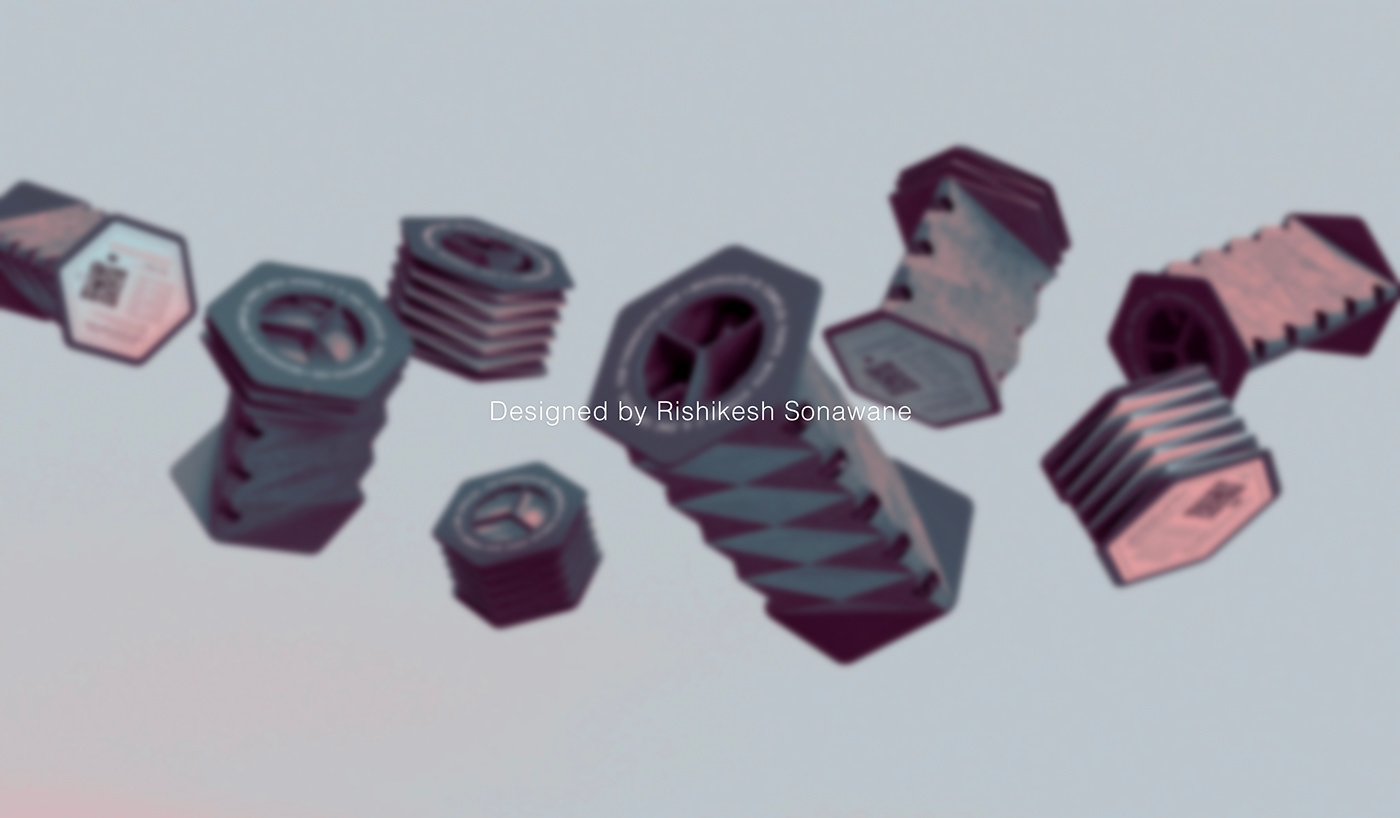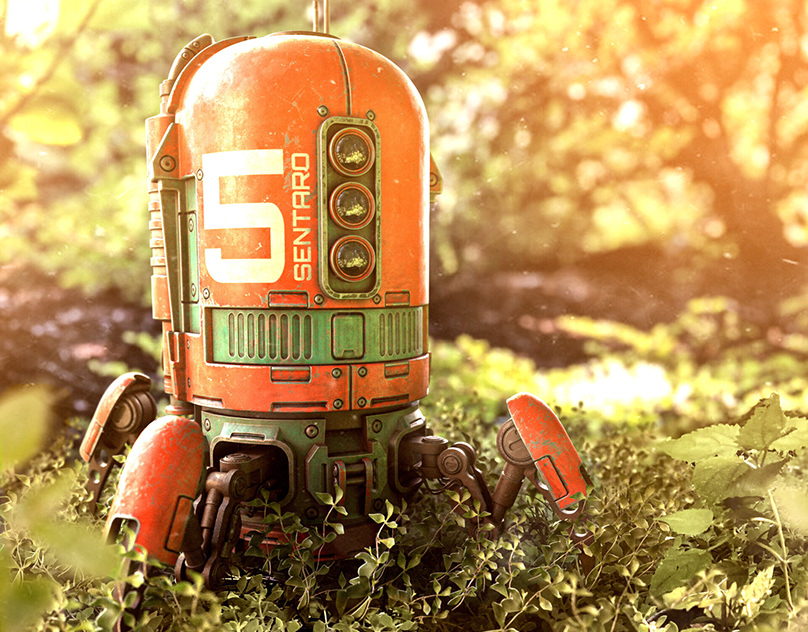HealthCare Product Design +
During the Covid-19 Pandemic, Becosules and Zincovite tablets were mass consumed for providing resistance against the virus. This packaging design approach was integrated with paper folding geometries such as the Yoshimura Buckling to create a unique more sustainable vitamin packaging. Targeting consumer psychologies, it creates a strong influence over the user in categories such as sustainable disposal or disposal for recyclability.
YOSHIMURA [TRIANGULAR MESH] BUCKLING
Industrial Design | 02 weeks | July 2021

Packaging Design
Type: Studio
Time: 04 weeks
Team: Individual Project
Brief
Exploring paper folding and buckling to implement into a real life product scenario. Packaging design has evolved from just serving as a covering/casing to a highly crucial human experience. Packaging strongly influence a users perception of the product inside. It can give a sense of quality, sophistication or even suspense.
The brief was to create a more product dependent packaging using innovative paper folding techniques to provide an experiential outlook. The experience contributes to the users mentality of possessing a user centric product, motivating them to dig deeper into the reasoning for this unique packaging approach.
Contents
Concept | Research | Conceptualisation & Ideation | Final Concept | Psychology & Recyclability | Mockup



Concept
Yoshimura Triangular Mesh Buckling
Yoshimura buckling is a triangular mesh buckling pattern found in thin-walled cylinders under compression along the axis of the cylinder, producing a corrugated shape resembling the Schwarz lantern. The reason this particular folding pattern intrigued me is because it converts a circular unified facade into a geometric pattern helping it collapse almost effortlessly. Using this benefit of collapsibility, that provides altering the bodies volume, made me incorporate it into a vitamin packaging where popped vitamin blister pack spaces are cut off creating micro waste.
Touch Points
Collapsibility | Micro Waste | Recyclability | Disposal Awareness | Interactive


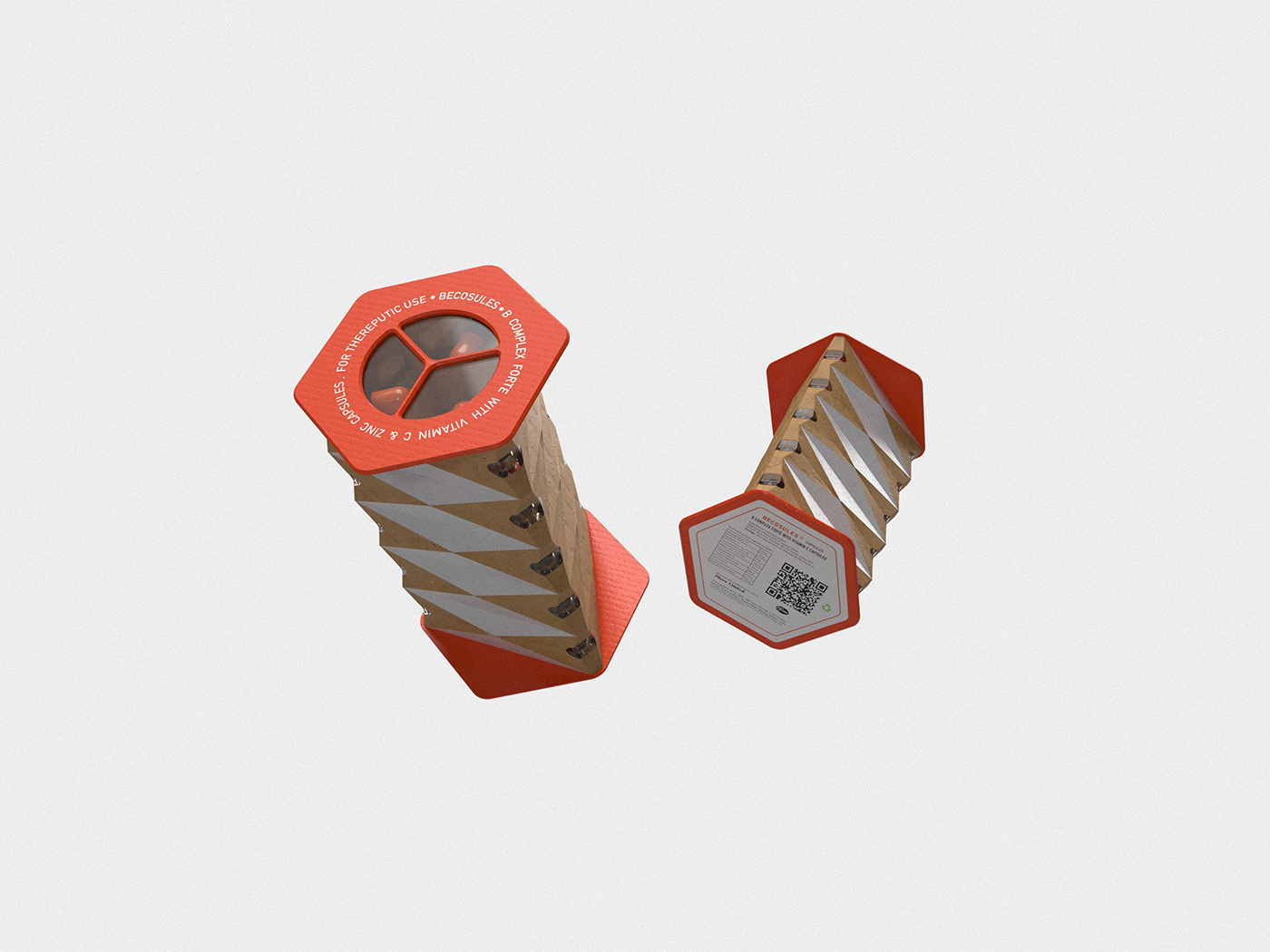
A viewing window to visually confirm the contained medication.


The writing spaces can be used to track vitamin consumption. Prescriptions can be written directly onto the vitamin casing.
Yoshimura Triangular Mesh Buckling
Collapsibility
Pharmacies can use a pair of scissors and cut the packs into required doses for users who need medications in smaller quantities. Incase of daily vitamins, whole packs are exhausted very frequently and are not sold in smaller doses. Users cut off excess plastic from packs for easy storage creating micro plastic waste.

Psychology & Recyclability
How does design influence user psychology to take one step closer to sustainability?
Design adds value to a product, interaction enables the user to notice products no matter their worth. Traditional blister packs serve the purpose of their creation but they contribute nothing towards sustainable manufacturing or recycling. Interacting with this vitamin packaging enables users to be more aware of what it signifies. Such as the QR code under the package demonstrates proper disposal/recycling methods. Having possession of something unique gives users a sense of inquisitiveness and responsibility eventually bringing behavioural change towards the product. It can also have a positive impact on individuals with ADHD or Autism.
Touch Points
Consumer Mentality | Awareness | Recyclability



Factors Affecting Packaging
Contamination, Sunlight, Storage, Usability, Disposal, Sustainability
Production cost
Blister packs are not cheap to produce at a small scale, cost is spread if the number of units is larger. 5000 units – cost per unit $1.65 – inclusive of the medicine inserted by hand. Why Blister packs are highly unsustainable?
Material used – PET / PVC – hard to recycle due to high levels of added hazardous materials. They can never be fully transparent once recycled. Most collected plastic waste is highly contaminated. Some Blister packs come with medicines making it hard to separate. Sorting – expensive considering the range and quantity of waste produced. Separating aluminium is hard as it is non-ferrous so it needs to be separated using a chemical process.
o How do I make pill packaging Sustainable?
o Usability
o Storability
o Disposal
Existing innovative blister packaging

Primary Research
01: How do order and receive Blister Packs?
Pharmacy 1 : The manager has a supplier, an individual after giving the order visits the store with the required product. The individual carries the medicines in a back pack usually on a 2 wheeler or sometimes a small van. The product is handed upfront usually tied in string or rubber bands or in a big plastic bag. Some medicines such as Dollo or Allegra are ordered in bulk and are delivered in a box manufactured by the company itself. The drug store does not have any direct contacts with the drug companies, any problems are mentioned to the supplier.
Pharmacy 2 : The pharmacy has its own network, an employ updates its stores needs on a company software and the products are delivered. They have no further knowledge of where the medicines come from, an individual working for the Nobel medicals brand delivers the medicines in a van.
02 : How are these Blister Packs sorted and stored?
Pharmacy 1 : Medicines are taken and kept in their allocated locations, a wall of different sized drawers. Blister packs are only stored in drawers, other medicines that come in bottles are stored in cupboards or shelves. The bigger box of the blister packs is usually discarded or sometimes used as extra storage not necessarily for the same medicine. Why in drawers? Because drawers are labelled on the outside with its contents, convenient to open and remove product. The blister packs with boxes are stacked spine up. Why not face up? No particular reason the manager says it saves space when it is spine up. Blister packs without boxes are held using rubber bands or compartments in the drawers itself.
Pharmacy 2 : Some medicines that have very less demand have a separate drawer with multiple compartments. There are drawers and shelves with trays for categories of medicines such as pain killers. Each drawer or tray has a number which is entered in a system. If the employ is unfamiliar with the medicine the system helps determine its location in the storage but those cases are very rare. The blister packs without boxes are stored spine up or face up there is no definite way of its placement. Blister packs without boxes are stored in their trays and are randomly placed because they cannot be stacked spine/face up for a long period of time.
03 : How are expired Blister Packs discarded?
Pharmacy 1 & 2 : They try and sell old stock first hence there is less expired waste. The expired products are taken back by the supplier. No individual has ever come to give a used blister pack for recycling. Some individuals do come to return unused medicines (tablets) but the store does not accept them.
User Survey - Google Forms

According to my survey, about 74% of the individuals were unaware about the proper disposal of blister packs and their impact on the environment. Almost no individual had knowledge regarding the disposal of expired medicines. After conducting my Primary Research I have noted the revised criteria that my invented packaging should follow in order to be as optimal as possible.
o Even though individuals are aware of blister packs being unsustainable they continue discarding them in dustbins. This is because there is no alternate way to dispose the pack- hence making it out of paper would be a sustainable option although looking at it from a manufacturing point of view might not be very viable.
o Some form of information on the packaging itself that informs the user of various ways to discard the package with or without medicines.
o A small note of the packages composition such as percentage values of the materials used example- 12% aluminium 72% paper 16% plastic, this will ensure they do not dispose it/recycle it in a wrong way.
o Most packs are stored in drawers because it is not easy to stack in cupboards or shelves hence the form of current blister packs could be altered to improve storability.
No blister packs are stored on shelves unless they have their own individual box. The box gives space for additional details regarding the medicine inside and also acts prevents dirt from coming in contact with the blister pack within. The boxes are designed to be stored both face up and spine up so it is up to the drug store when it comes to storing them. Inexpensive blister packs do not come in boxes. They are usually bought in bulk. Expensive tablets are usually bought at a smaller rate - as per demand. Stocking on such tablets can be expensive for the drug stores.

Sometimes blister packs have an unusual amount of empty space between the tablets. This wastes a large amount of resources during its manufacturing. These spaces are purposely left out as a lot of the same machines are used for the production of multiple medicines. Some machines are unable to adapt to change. Instead of adding a new piece of machinery to eliminate the wasted space, the drug manufacturer lets it be as it is much cheaper to keep the production line running as it is; and if the demand or price of the product is inexpensive, then this makes it the most financially viable option. This technique is not only used in blister packs but also some other forms of packaging such as the pre made cases for the shaving blades. The manufacturers put the cost of manufacturing before keeping the products environmentally sustainability in mind. Each business wants to cut down manufacturing costs as much as possible, which is why although plastic is extremely harmful, it is very inexpensive and very easy to manipulate.

1872 a German scientist names August Wilhelm invented an early form of PVC, the material at that point was unstable but it was perfected over the course of 2 years. Multiple innovation added to the PVC making it extremely versatile.
Types of blister packaging
o Face-seal blister packaging
o Trapped blister packaging
o Clamshell packaging
o Tri-fold clamshell
o Skin packaging
Blister packs became highly popular in the 1960s. Before that oral contraceptive pills were sold in metal or cardboard boxes or glass tubes/bottles. These packaging methods were hard to use at a larger scale. Due to high demand for pharmaceutical tablets because of medical advancements, companies had to come up with something more viable to meet the exceeding demand. A group of German firms came up with machines designed to package pills at an inexpensive and fast rate. By 1980, blister packaging was extensively used worldwide. Technological advancements enabled drug manufactures to produce more and more drugs. Today at an average 1200 blister packs can be produced in a span of just 60 seconds. This method has been used for decades, back then plastic pollution was nothing to worry. Increasing population has also had a huge impact on the rate of blister pack manufacturing.

Ideation Mockups - Scale 1 : 1

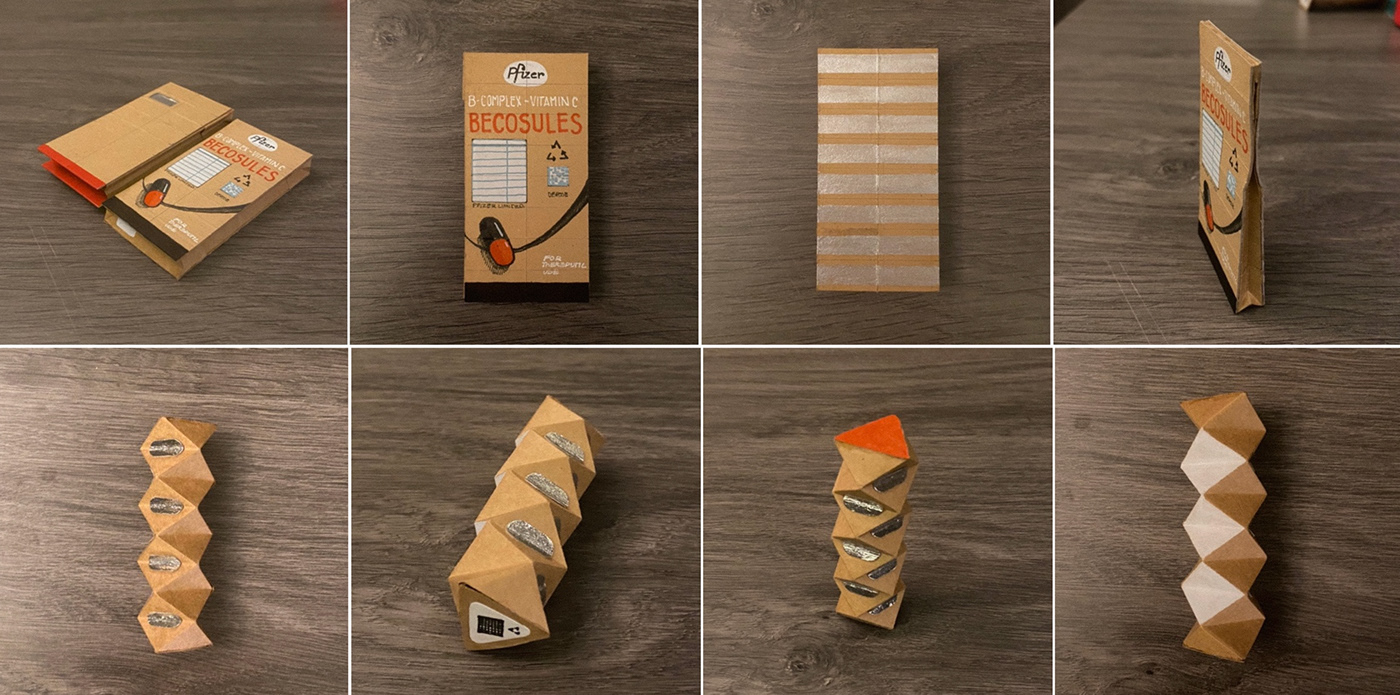
Final Mockup - Scale 1 : 1
Materials used - Paper, Becosules capsules, OHP sheet, Aluminium Foil
